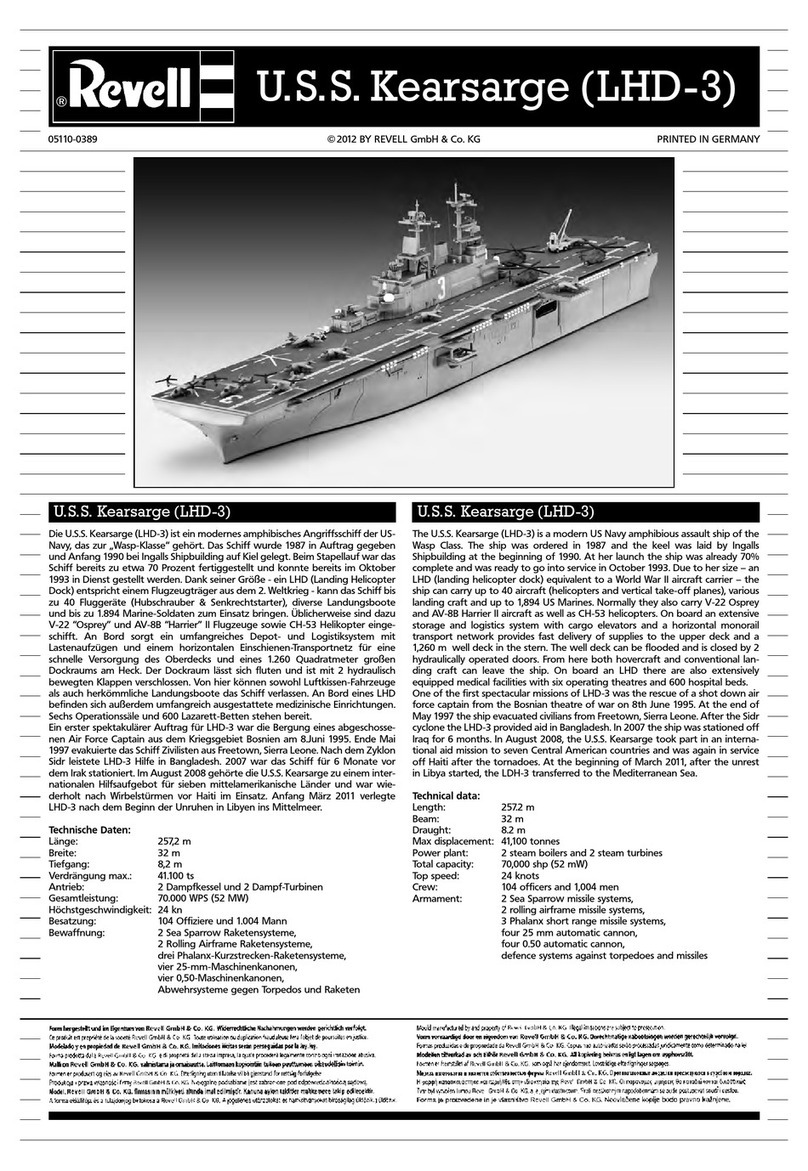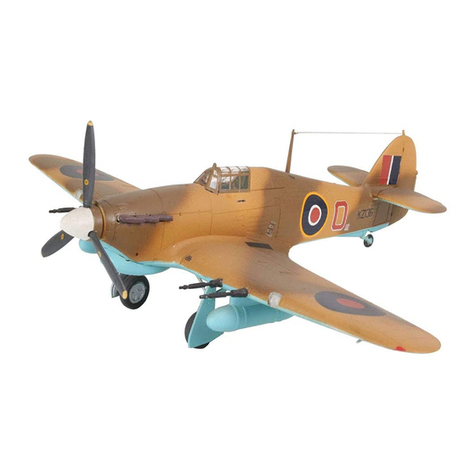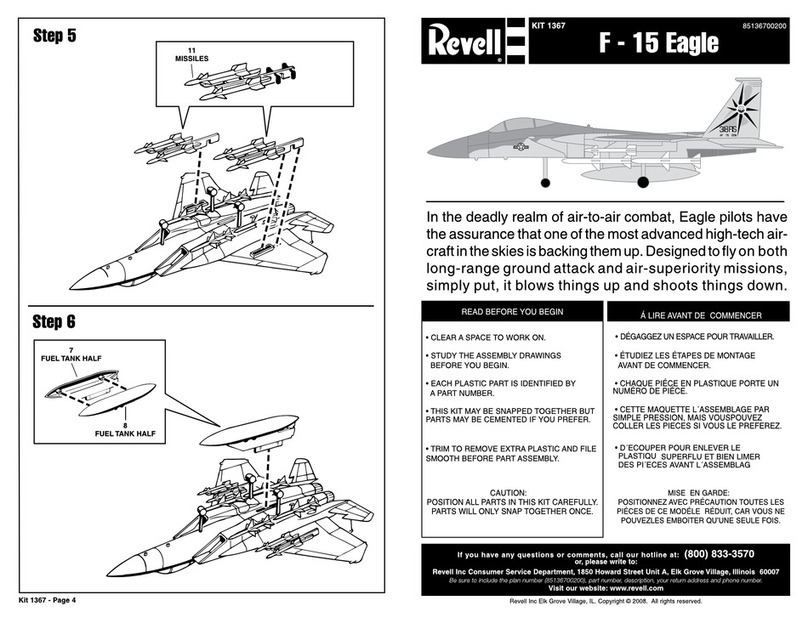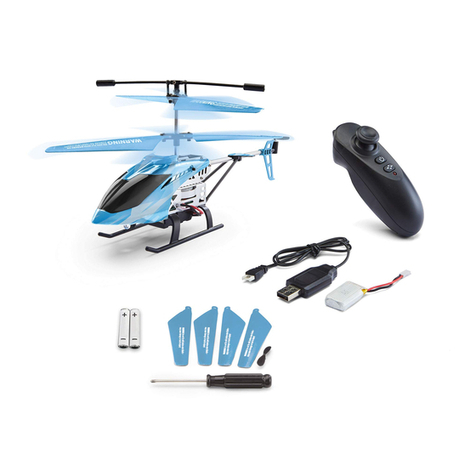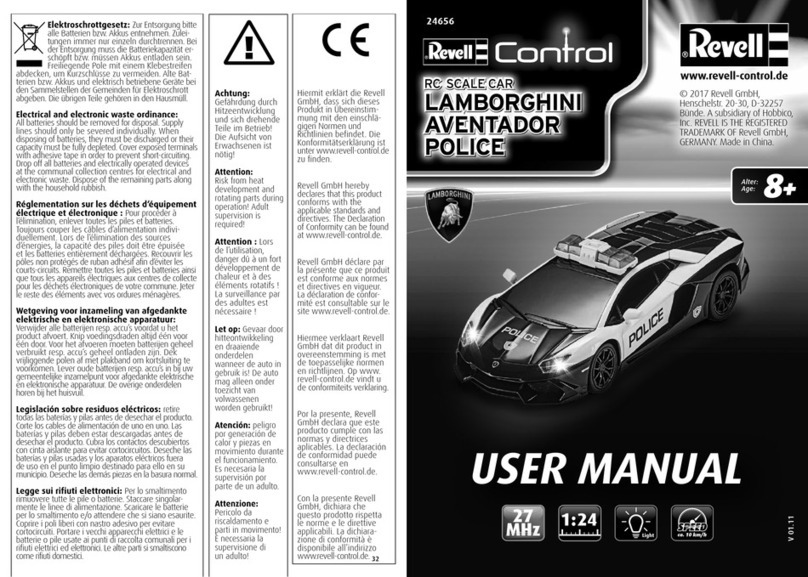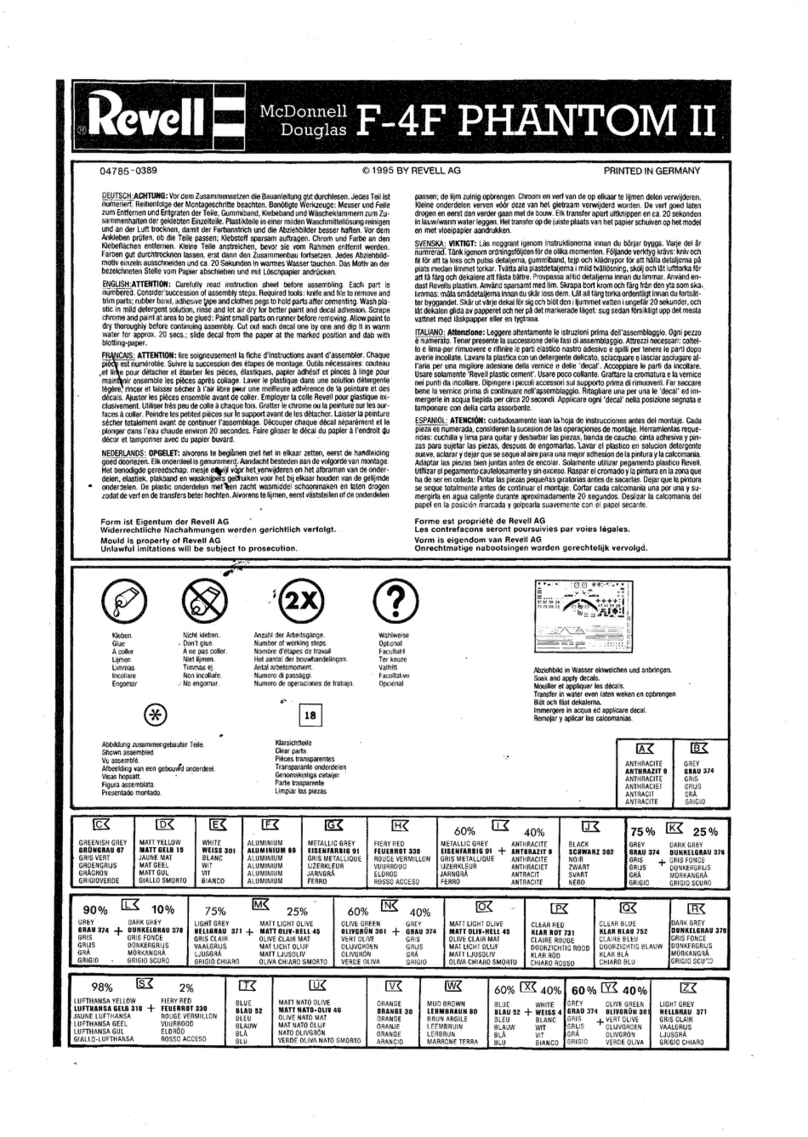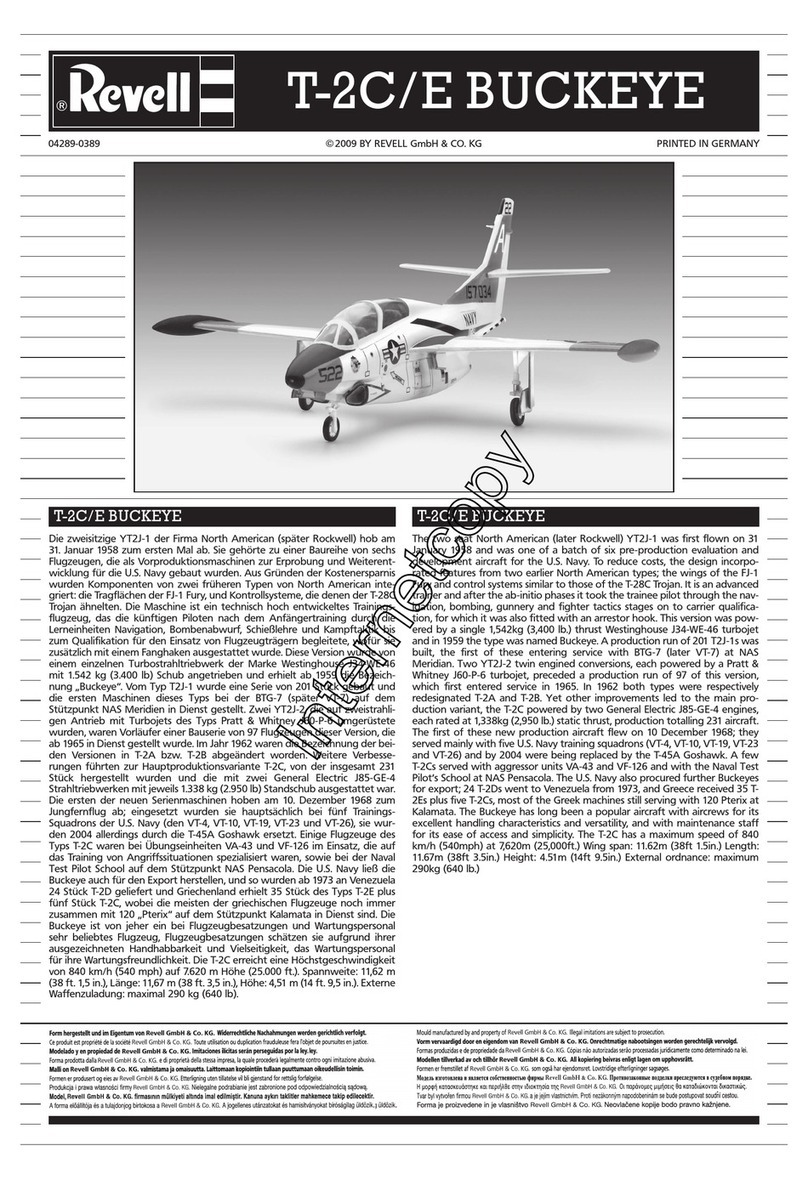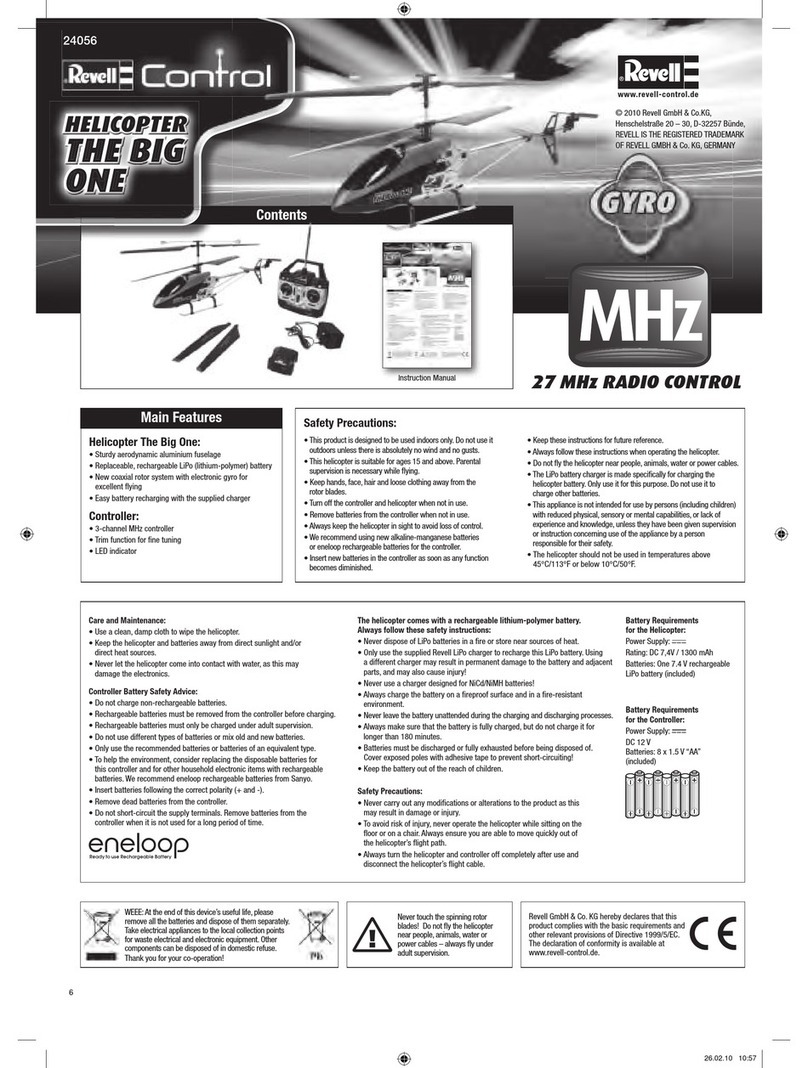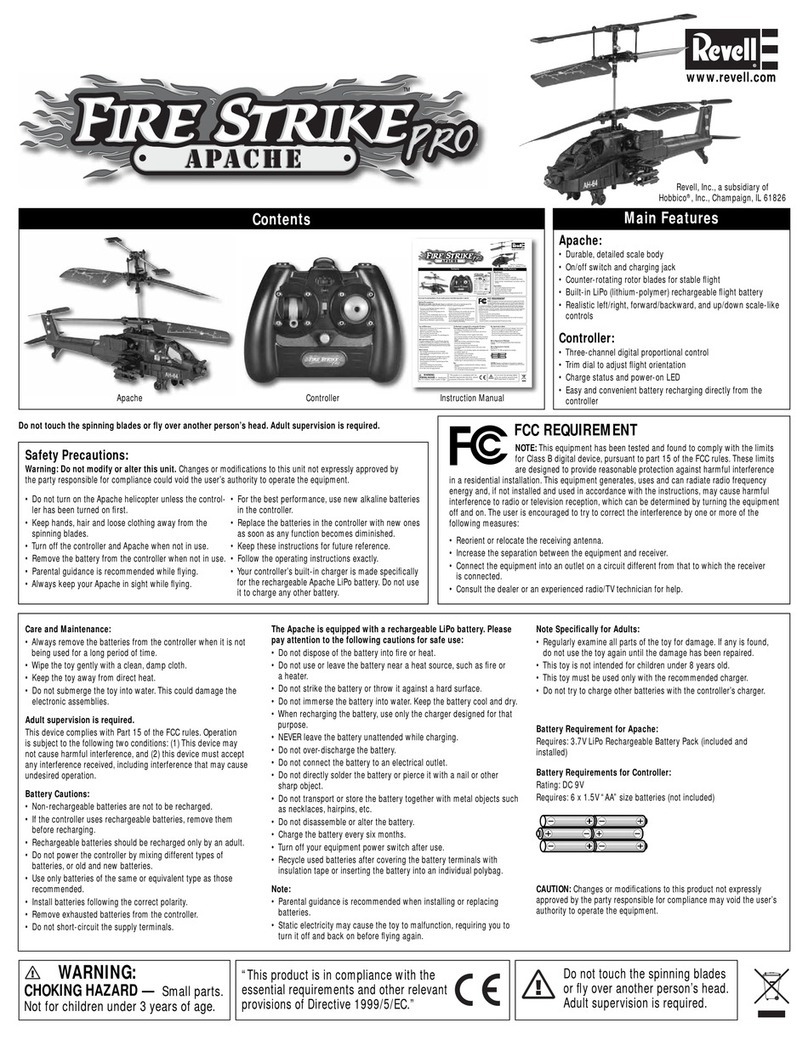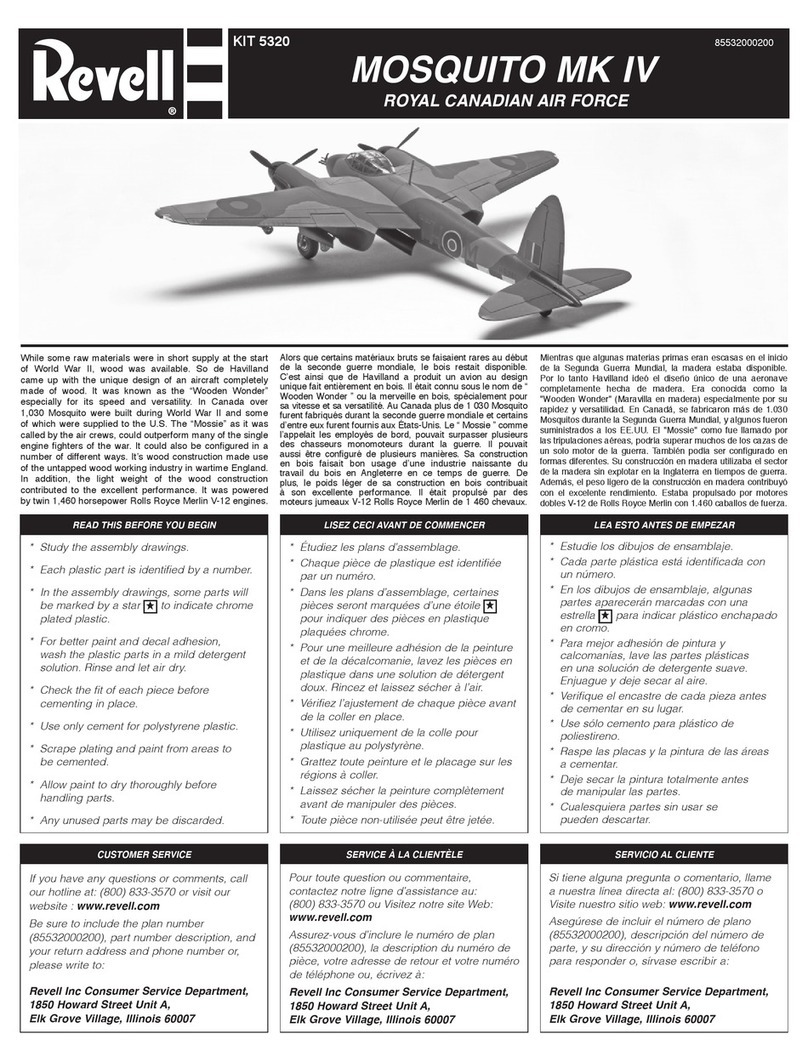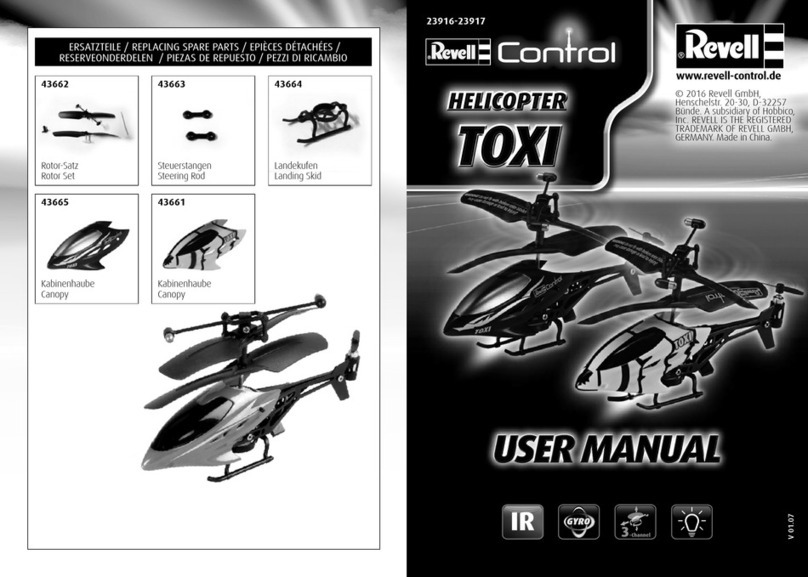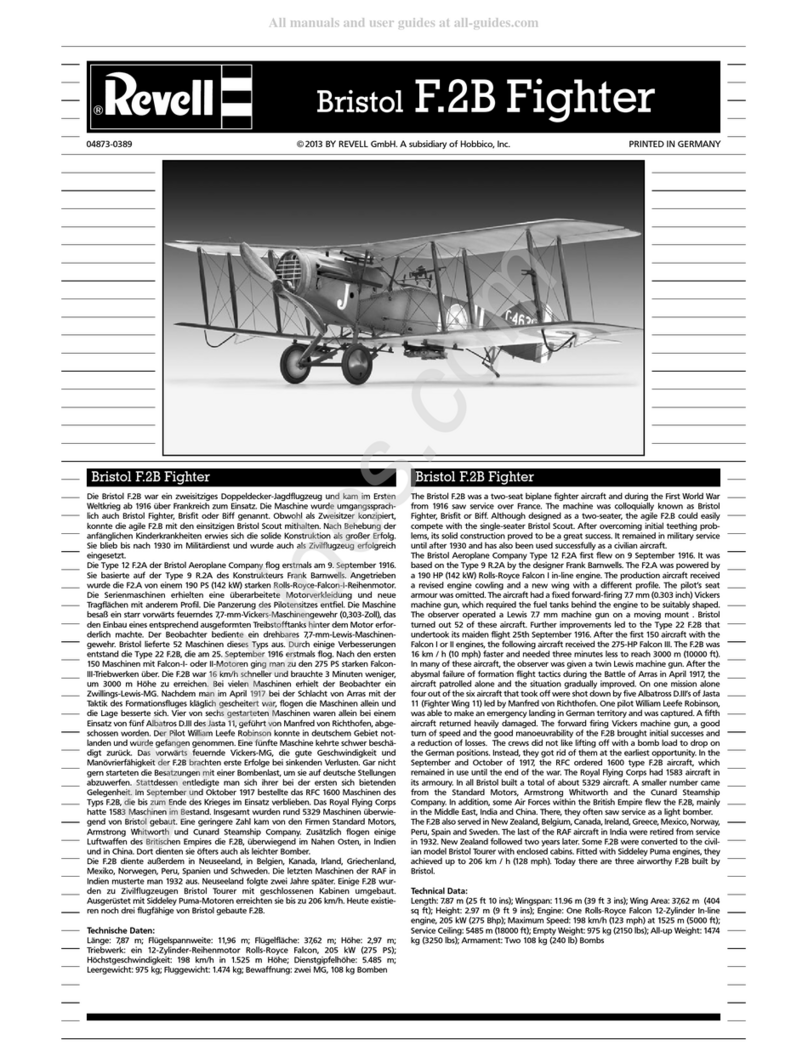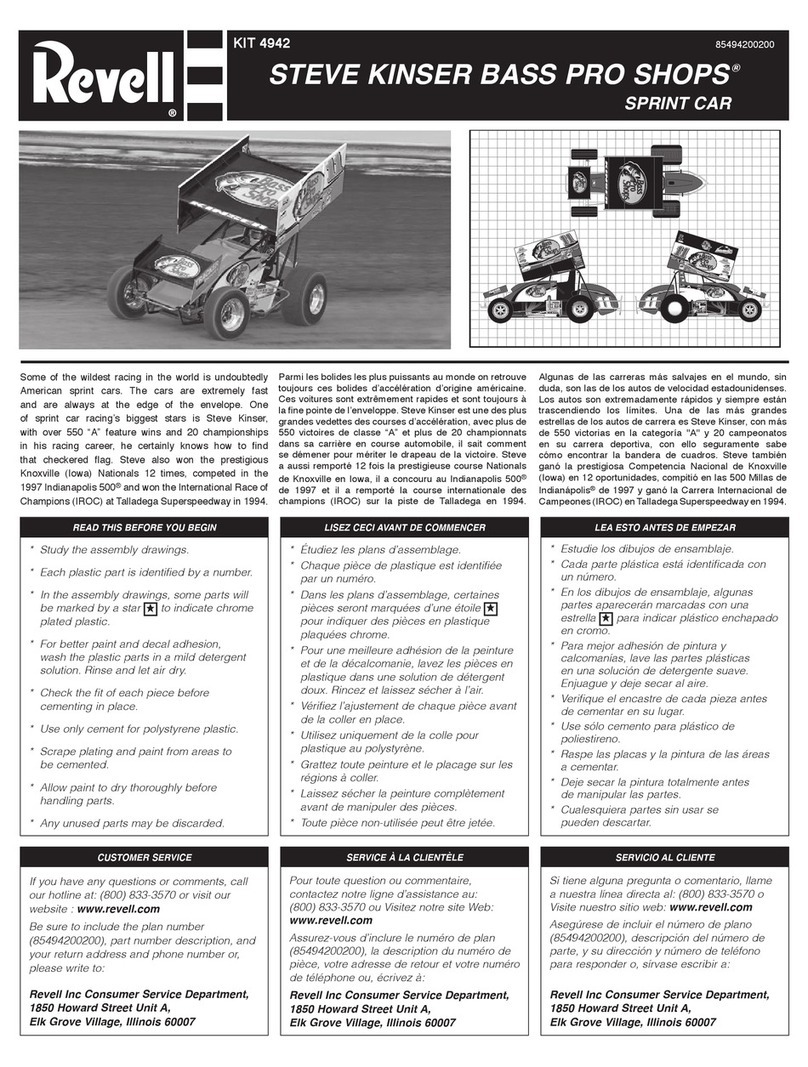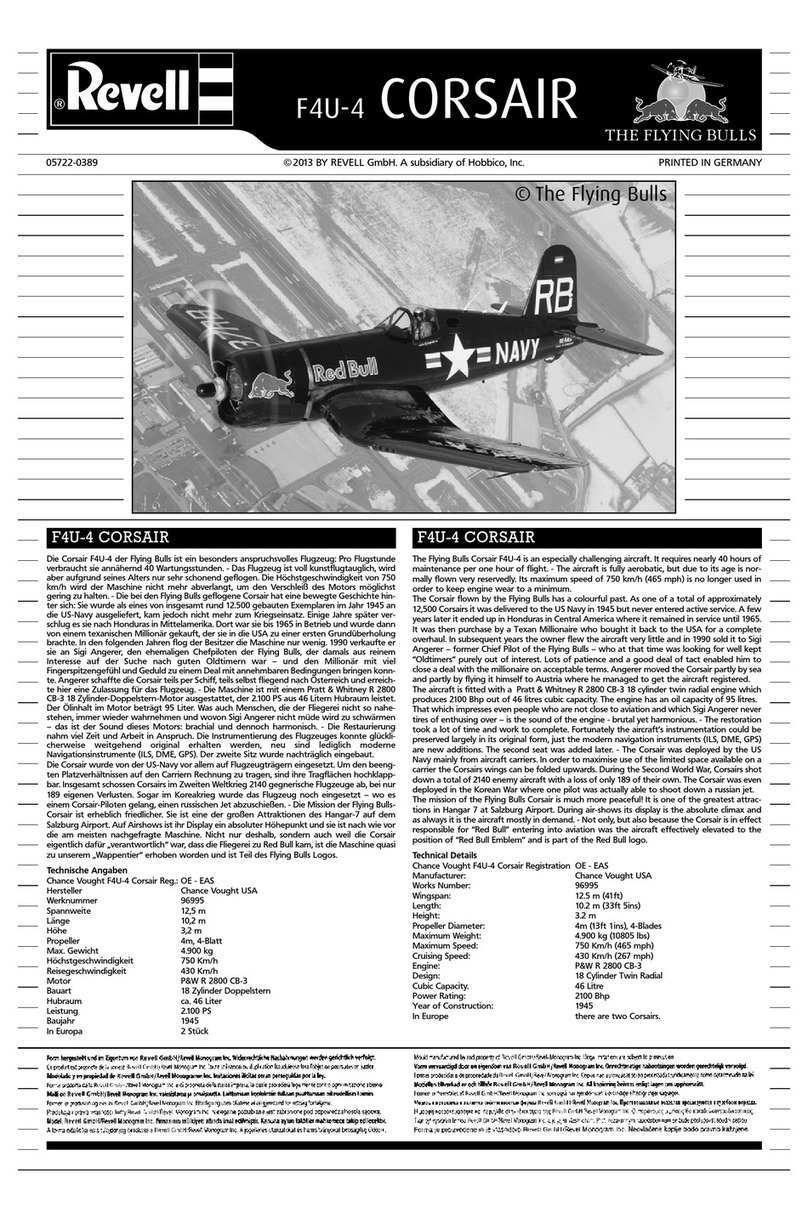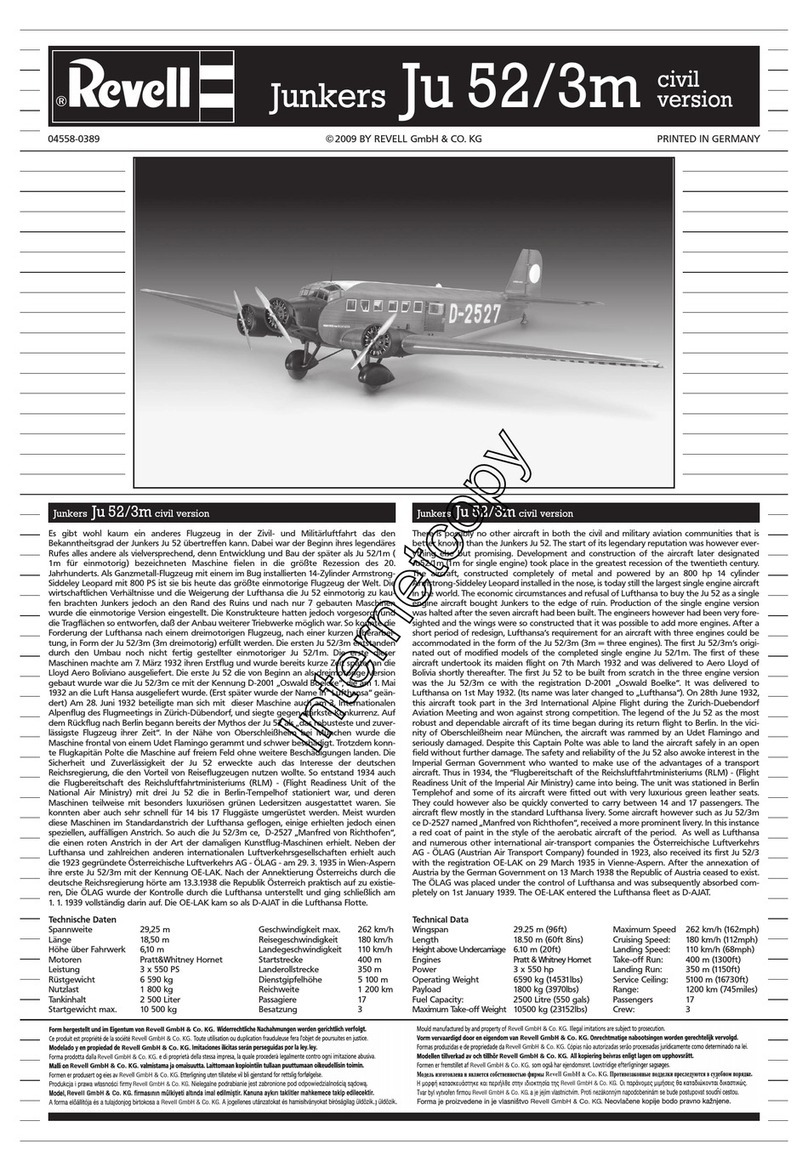MiL Mi-26 „HALO“
04645-0389 2009 BY REVELL GmbH & CO. KG PRINTED IN GERMANY
MiL Mi-26 „HALO“ MiL Mi-26 „HALO“
Der Mil Mi-26 (NATO-Code „Halo“) ist der schwerste und größte in Serie gebaute Hubschrauber
der Welt. Die staatliche Fluggesellschaft AEROFLOT benötigte Anfang der 1970er Jahre einen ver-
besserten Schwerlasthubschrauber zur Erschließung und Versorgung abgelegener Regionen des
Landes. Für den neuen Hubschrauber forderte die sowjetische Luftwaffe eine Nutzlast bis 20
Tonnen und 800 km Reichweite. Bis in eine Höhe von 1.500 m über dem Meeresspiegel sollte die
Maschine uneingeschränkt start- und landefähig sein.
Das OKB Mil begann mit der Entwicklung eines Nachfolgers für den veralteten Mi-6 (Erstflug: Juni
1957). Bei einer sehr ähnlichen Größe und Konstruktion in Ganzmetall-Schalenbauweise sollte der
Mi-26 weitaus leistungsfähiger werden. Die beiden Lotarew-Turbinen mit zusammen 22.800
Wellen-PS und das Hauptgetriebe sind das Herzstück dieses Super-Helicopters. Gegenüber dem
Mi-6 sind keine Stummelflügel zur Verbesserung des Auftriebes nötig. Deren störender
Luftwiderstand entfällt im Horizontalflug. Bei Ausfall einer Turbine regelt die zweite automatisch
zum Ausgleich hoch. Die Rotorköpfe des achtblättrigen Hauptrotors und des Fünfblatt-Heckrotors
bestehen aus Titan. Der Hauptrotor arbeitet mit konstant 132 Umdrehungen pro Minute. Die
Rotorblätter, Cockpitscheiben und Turbineneinlässe sind beheizbar, um einen Einsatz auch bei tief-
sten Temperaturen zu ermöglichen. Die von den Triebwerken angesaugte Luft wird permanent
mit einer Filteranlage vor jedem Lufteinlauf gereinigt. Die feuerfeste Abtrennung jeder Turbine ist
mit Brandschotten aus Titan realisiert. Das Hauptfahrwerk lässt sich am Boden in der Höhe hydrau-
lisch verstellen, um die Höhe der Laderampe variieren zu können. Der Laderaum ist über
Heckklappen und eine Laderampe zugänglich. Die Hydraulikanlage ist in zwei Haupt- und ein
Notsystem unterteilt. Mit einer 160-PS-APU-Anlage unter dem Cockpit ist der Hubschrauber unab-
hängig von einer externen Bodenversorgung mit Strom und Druckluft. Das Hilfstriebwerk erlaubt
den eigenständigen Triebwerkstart und die Klimatisierung der Pilotenkanzel. Am 14. Dezember
1977 startete der Prototyp zum erfolgreichen Jungfernflug. Die Serienproduktion begann 1980.
Sein internationales Debüt hatte der Hubschrauber auf der Paris Air Show 1981. Am 3. Februar
1982 stellte der Mi-26 eine Reihe neuer Rekorde auf, darunter ein Flug mit einem Gesamtgewicht
von 56,8 t bis auf 2000 m Höhe. Ab 1983 wurde er mit insgesamt 60 Exemplaren bei der damali-
gen sowjetischen Luftwaffe eingeführt. Die Militärversion verfügt über ein gepanzertes Cockpit,
selbst dichtende Tanks, eine Feuerlöscheinrichtung und alle wichtigen Flugsysteme in doppelter
Ausführung. Um den taktischen und fliegerischen Wert des gigantischen Fluggerätes zu steigern,
wurden alle Maschinen ab 1985 als Mi-26 A mit einem Autopiloten, einer Hover-Automatik (auto-
matische Schwebeflug-Stabilisierungsanlage) und moderner Avionik für den Allwetter- und
Nachteinsatz ausgestattet. Der Frachtraum des Mi-26T entspricht dem einer Lockheed C-130
„Hercules“. Er kann 90 voll ausgerüstete Soldaten oder zwei Luftlande-Kampffahrzeuge oder
einen 20-Tonnen-Standard-Container aufnehmen. Die interne Motorwinde ist für 500 kg
Anhängelast ausgelegt. Zwei elektrische Winden laufen in Schienen an der Kabinendecke. Jede ist
für eine Last bis 2,5 t ausgelegt. Für die Überwachung einer Außenlast im Flug ist ein TV-System
im fliegenden Kran Mi-26TM eingebaut. Ausgerüstet mit stärkeren Triebwerken und
Rotorblättern aus Verbundwerkstoff transportiert die Version Mi-26M eine Nutzlast von bis zu 22
Tonnen. Für den Feuerlöscheinsatz ausgerüstet ist der Mi-26TP. Die Moskauer Feuerwehr verfügt
seit 1999 über ein Exemplar. Die zivile Passagierversion Mi-26 P kann 63 Passagiere und Gepäck
transportieren. Der Mi-26 MS mit Ambulanzausstattung ist für 32 Patienten und 7 Pfleger oder als
fliegende Intensivstation für 7 Patienten einsetzbar. Der russische Katastrophenschutz unterhält
mehrere Mi-26 MS für den Transport und die Notversorgung von bis zu 60 Menschen. Der Mi-26
TZ ist die „Tankerversion“ für 14.000 Liter Treibstoff und 1.000 Liter Schmieröl. Die „Indian Air Force“
(IAF) war der erste Exportkunde mit 10 Maschinen im Juni 1986. Die Ukraine hat zusammen mit
Mil-Avia 20 Maschinen in ihrem Bestand. In Griechenland werden zwei Mi-26 unter anderem als
Löschhubschrauber eingesetzt. Die Firma Samsung Aerospace Industries in Südkorea hat 1997
einen Mi-26TS gekauft. Zwei Mi-26 wurden im Jahr 2000 nach Mexiko geliefert. Peru unterhält
ebenfalls zwei Maschinen.
Die Armeestreitkräfte von Venezuela, Kasachstan und Kambodscha verwenden Mi-26.
Die Vereinten Nationen setzen mehrere Mi-26 ein. Belorussland verfügt über 15 Mi-26. Bis 2001
wurden rund 300 Maschinen im Rostvertol-Werk in Rostov am Don montiert.
Technische Daten:
Besatzung: 5 (zwei Piloten, Navigator, Techniker, Lademeister); Gesamtlänge: 40,025 m (bei dre-
henden Rotoren); Rumpflänge: 33,73 m (ohne Heckrotor); Rotordurchmesser: 32 m; Heckrotor:
7,61 m; Rotorkreisfläche: 804,25 qm; Höhe bis Rotorkopf: 8,15 m; Höhe, gesamt: 11,60 m (mit dre-
hendem Heckrotor); Rumpflänge: 33,73 m; Breite: 6,15 m (Hauptfahrwerksräder); Frachtraum:
12,08 x 3,25 x 2,91 bis 3,17m (Länge x Breite x Höhe); Antrieb: 2 ZMKB Progress Lotarew D-136 (je
8.500 kW=11.400 WPS); Marschgeschw.: 265 km/h; Höchstgeschw.: 295 km/h in 500 m Höhe;
Einsatzreichweite: 800 km; Überführungsreichw.: 1.920 km; Leermasse: 28,27 t; Startgewicht: 49,5
t; Startgewicht / max.: 56 t; Nutzlast / max.: 20 t; Außenlast / max.: 20 t (bei 54 t Startgewicht);
Kraftstoffvorrat: 9.323 l (mit Zusatztanks: 11.480 l); Gipfelhöhe: 4.600 m; Passagiere: 4
(Transportversion); Selbstverteidigung: ASU-2V Täuschkörperwerfer an den Rumpfseiten.
The Mil Mi-26 (NATO-Code „Halo“) is the largest and heaviest helicopter built in series production
in the world. At the beginning of the 70’s the publicly owned aviation company “Aeroflot”
required an improved heavy lift helicopter in order to access and supply the remote regions of the
country. The Soviet Air Force demanded a payload of 20 tons and a range 800km (500miles). The
aircraft should be able to take-off and land unrestricted up to an altitude of 1500m (4500ft) above
Mean Sea Level. OKB Mil started development of a successor to the ageing Mi-6 (maiden flight
June 1957). Constructed completely of metal sheet technology the Mi-26 was to be very similar in
size and considerably more powerful.
The main components of this Super Helicopter are the main gearbox and Lotarew Turbines deliv-
ering a total of 22,800 Shaft Horsepower. In contrast to the Mi-6, stub wings were not required
to augment lift. Their disruptive drag is therefore not present during straight and level flight. If
one turbine fails, the second turbine automatically runs up to compensate for the loss of power.
The heads of the eight-blade main rotor and the five blade tail rotor are constructed of titanium.
The main rotor works at a constant 132 rpm. The rotor blades, cockpit windscreens and turbine
inlets are heated in order to permit operation at the lowest temperatures. Turbine inlet air is per-
manently “cleaned” by filter units in front of each engine. Fire-proof separation of the engine bays
is realised with firewalls constructed of titanium.
On the ground, the main undercarriage can be hydraulically adjusted in order to vary the height
of the loading ramp. The cargo bay can be accessed via rear doors and a loading ramp. The
hydraulic system is divided into a main and an emergency system. With a 160hp APU under the
cockpit the helicopter is independent of an external ground supply unit for electric power and
compressed air. The APU allows a stand-alone engine start and the acclimatisation of the cockpit.
On 14 December 1977 the prototype took-off on its successful maiden flight. Serial production
commenced in 1980. The helicopter made its international debut at the Paris Air Show 1981. On 3
February 1982 the Mi-26 achieved a number of new records including flight with a total All-up
Mass of 56.8tons up to an altitude of 2000m (6000ft). The Soviet Air Force received a total of 60
helicopters from 1983 onwards. The military version had an armoured cockpit, self-sealing fuel
tanks, a fire extinguishing system and all major flight systems were duplicated. After 1985 all air-
craft were fitted with an auto-pilot, an automatic hover stabilisation control system and a mod-
ern avionics suite for night and all weather operations in order to improve the tactical and air-
borne value of this gigantic flying machine, now re-designated Mi-26A. The cargo-bay of the
Mi26T is similar in size to that of a Lockheed C-130 „Hercules“. It can accommodate 90 fully
equipped troops, two air-mobile fighting vehicles or a 20ton standard container. The internal
motor driven winch is constructed to pull a 500kg load. Two electric winches run in rails in the
cabin roof. Each is built for a load of 2.5tons. A TV system is built into the Mi-26TM Flying Crane
in order to observe external loads during flight. Fitted with more powerful engines and rotor-
blades of composite materials the Mi-26M version can transport a payload of up to 22tons. The
Mi-26TP is equipped for the Fire-Fighting role. In 1999 the Moscow Fire Service had one Mi-26TP
at its disposal. The civil passenger carrying version Mi-26P can carry 63 passengers and their bag-
gage. The Mi-26MS equipped as an air-ambulance can carry 32 patients and 7 medics or can be
used as an aerial Intensive Care Unit for 7 patients. The Russian Civil Emergency Services have many
Mi-26MS for the transport and emergency supply of up to 60 people. The Mi-26TZ is the „Tanker“
version with a capacity of up to 14,000 litres (3080gals) of fuel and 1000 litre (220gals) of lubri-
cants. The Indian Air Force (IAF) was the first export customer ordering 10 aircraft in June 1986.
Together with Mil-Avia the Ukraine had 20 helicopters in its inventory. Two Mi-26 were also used
in Greece for Fire-Fighting. Samsung Aerospace Industries of South Korea purchased a Mi-26TS in
1997.
Two Mi-26 were delivered to Mexico in the year 2000. Peru also operates two aircraft.
The Mi-26 is also used by the Armed Forces of Venezuela, Kazakhstan and Cambodia. The United
Nations employ many Mi-26. Bylore Russia has a total of 15. Until 2001 around 300 helicopters
were constructed in the Restvertol Works in Rostov on the Don.
Technical Data:
Crew: 5 (2 Pilots, Navigator, Technician, Loadmaster); Overall Length: 40.025 m (131ft 3ins) with
rotors turning; Fuselage Length: 33.73 m (11ft 7ins) without tail rotor; Rotor Diameter: 32 m
(105ft); Tail Rotor: 7.61 m (25ft); Rotor Disk Area: 804.25 sq.m (8653 sq. ft.); Height to Rotor-head:
8.15 m (26 ft 8ins); Height over all: 11.60 m (38ft) with turning tail-rotor; Width: 6.15 m (20ft 2ins)
over main undercarriage; Cargo Hold: 12.08 x 3,25 x 2.91 to 3.17m (LxWxH) 39ft 7ins x 10ft 8ins x
9ft 6ins to 10ft 5ins (LxWxH); Engines: 2 ZMKB Progress Lotarew D-136 (each 8.500 kW=11.400
WPS); Cruising Speed: 265 km/h (165mph); Maximum Speed: 295 km/h (183mph) at 500 m (1640ft)
Altitude; Operational Range: 800 km (496miles); Ferry Range: 1.920 km (1192miles); Weight Empty:
28.27 t; Take-off Weight: 49,5 t; Take-off Weight Max: 56 t; Payload max: 20 t; External Load max.:
20 t (with 54 t Take-off Weight); Fuel Capacity: 9,323 ltr (2051gals)(with Extra tanks: 11,480 ltr –
2526gals); Service Ceiling: 4,600 m (15,088ft); Passengers: 4 (Transport Version); Self Defense: ASU-
2V Chaff Dispensers on the fuselage sides.
